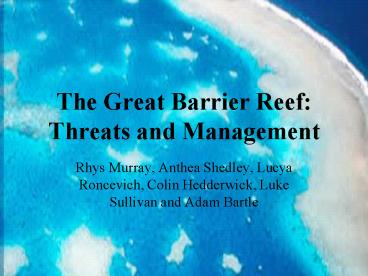The Great Barrier Reef: Threats and Management
1 / 25
Title:
The Great Barrier Reef: Threats and Management
Description:
Title: The Great Barrier Reef: Threats and Management Author: imageUser Last modified by: aa Created Date: 5/22/2005 4:17:10 AM Document presentation format –
Number of Views:1268
Avg rating:3.0/5.0
Title: The Great Barrier Reef: Threats and Management
1
The Great Barrier Reef Threats and Management
- Rhys Murray, Anthea Shedley, Lucya Roncevich,
Colin Hedderwick, Luke Sullivan and Adam Bartle
2
Introduction
- Threats and Prioritisation
- Issues Explained
- Management
- Recommendations
3
Threats and Prioritisation
Note Consequence classified using scale of 1?5
Where 1 complete extinction, 3 local
irreversible damage, 5 Minor Damage.
4
Water Quality
- The Burdekin catchment is a major source of Water
Quality pollutants and is ranked as the most
significant risk are in the total GBR catchment. - Contributes 6 x 106 tonnes of sediment per
annum (approximately 40 of total GBR catchment
input) - Contributes 40,000 tonnes on Nitrogen and
15,000 tonnes of Phosphorus per annum
5
Causes.
6
- Sediment Impacts on the Great Barrier Reef
- Smothering by settlement
- Turbidity inhibiting photosynthesis and growth
- However a natural turbidity gradient exists
some corals are more resilient than others
7
Nutrient Impacts on the Great Barrier Reef
- Increased phytoplankton growth (leads to an
increase in filter feeders and bivalves, which
compete for space) - Macro-algae blooms (overgrow coral and shade them
out) - Faster Coral Growth (less dense and weaker
skeletons are more prone to storm damage) - Inhibition of Fertility rates
8
Fishing
- The GBR sustains a 250 million fishing industry
- Trawling (8,200 tonnes)
- Reef-line (Commercial 3000 4000 tonnes,
Recreational estimated at 2000 tonnes)
9
Shipping
- The GBRMP facilitates Australias major
commercial trading routes, and contains five out
of six of Queenslands major ports - Approximately 6000 ships greater than 50m length
pass through the reef per year - Damage is done to the reef through fire,
grounding, sinking and spills - Oil spills pose the greatest risk for
point-source pollution from boating
10
Coral Bleaching
11
Coral Bleaching
- Causes
- - Elevated Sea Temperatures
- - High Light Intensity
- - Low Salinity
- - Pollutants
- In recent years high sea temperatures have been
the major cause of coral bleaching
12
Crown of Thorns
13
Crown of Thorns
- Is it a problem????
14
Current Management
- Many regulatory bodies involved in the management
of the GBR i.e. Commonwealth Government, GBR
Marine Park Authority, Australian Fisheries
Management Authority etc. - Consequently, management policies often overlap
or leave out important threats to the GBR in the
current statutes.
15
Current Management
- Current management fails to adequately address
the issue of water quality. - Zoning aims to balance reasonable human use with
the maintenance of natural and cultural integrity - Mandatory pilotage of vessels through
navigationally hazardous areas and reducing
traffic through high risk areas
16
Current Management
- No current polices to prevent coral bleaching
- To hard to manage due to the fact that global
management is required to prevent rising sea
temperatures. - Crown of thorns is hard to manage and its effect
on the reef is unsure in the longterm
17
Recommendations
- Agriculture in the GBR catchment should be
managed as a source of diffuse pollutants,
particularly in relation to controlling
agricultural practice in the sugarcane and beef
grazing industry. - Trash blanketing
- Ground cover
- Certain areas should have certain practices made
mandatory, not voluntary, with cost incentives
for encouragement as 90 of pollutants come from
30 of the GBR catchment area.
18
Recommendations
- Fishing is currently regulated fairly
effectively. - Improvements to the system could be made
- Detailed stock analysis in different areas
- Valid logbook catch recording system
- Analysis of mortality rates from trawling
- Spatial partitioning to reduce over fishing
certain areas
19
Recommendations
- Shipping is already highly monitored.
- Improvements to the system could be made
- Reducing total boating hours within the reef
- Upgrading navigational charts
- Restricting the size of boats using high risk
areas - Improve education of recreational boat users
- about, ballast water, sewerage, and litter
20
Recommendations
- Improve public awareness on the impacts of global
warming with respect to coral bleaching on the
GBR - every little bit helps
- Continue crown of thorns starfish research and
monitoring
21
Application to Ningaloo
22
Application to Ningaloo
- Ningaloo is a completely different system to the
GBR - Existing threats are different
- Leads to different management policies
23
Application to Ningaloo
- Water Quality pollution is limited to point
sources, such as effluent waste, as there is no
significant river system leading to the diffuse
leaching of sediment and nutrients into the reef
environment. - Over fishing and shipping are believed to have
greater effect on the reef as the reef is
restricted to small localised patches. Over
fishing and localised boating pollution can hence
play a significant role in reducing reef
biodiversity.
24
Application to Ningaloo
- Bleaching is potentially more disastrous, as
reefs are isolated limiting regrowth after
bleaching events. - Crown of Thorns is present in small patches but
is effect is once again unknown.
25
Conclusion
- Thanks for Listening

